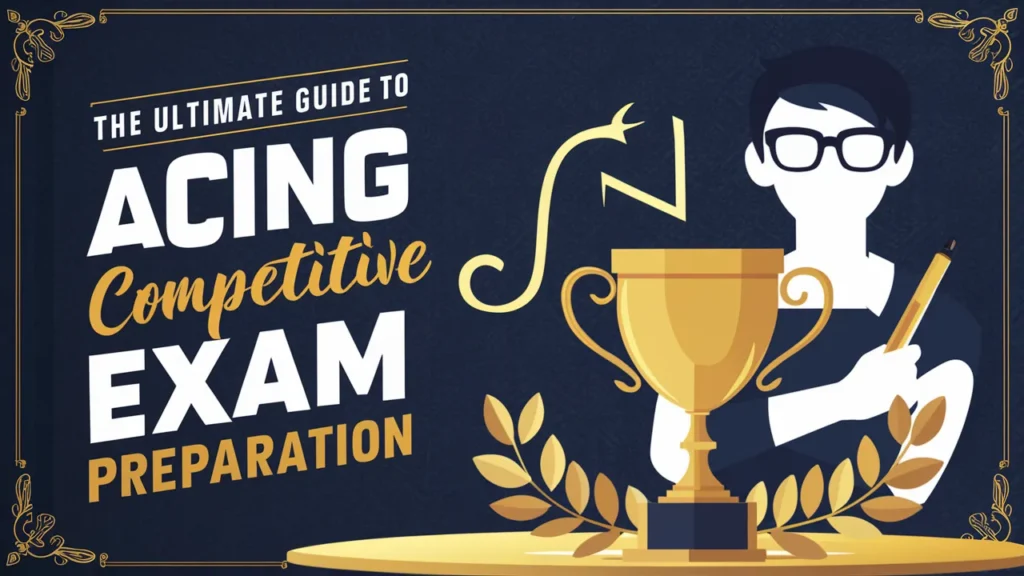
Competitive exams can be a major challenge due to their vast syllabuses and the need for effective time management. Traditional study methods may not always be enough to help students retain and organize large amounts of information. This is where mind maps come in—a powerful tool to enhance learning and memory retention. In this blog, we will explore the power of mind maps and how you can leverage them to improve your preparation for competitive exams.
Mind maps are visual diagrams that help you organize information by connecting related ideas and concepts. They engage both hemispheres of the brain, making learning more efficient. Not only do mind maps simplify complex information, but they also promote creativity, aid in understanding relationships between topics, and support better recall during exams.
In this guide, we’ll explore the following key aspects:
- What is a Mind Map?
- Why Mind Maps Are Effective for Competitive Exam Preparation
- How to Create a Mind Map for Exam Preparation
- Mind Mapping Software and Tools
- Incorporating Mind Maps into Your Study Routine
- Success Stories: Mind Maps in Action
- Tips for Maximizing the Power of Mind Maps
1. What is a Mind Map?
A mind map is a visual representation of information that begins with a central idea or topic and branches out into related subtopics and details. These branches can contain keywords, images, or symbols, making it easier to break down and understand complex information.
At the center of the mind map is the main concept (for instance, “Physics for Competitive Exams”), and surrounding it are branches representing different subtopics (e.g., “Mechanics,” “Thermodynamics”). From these branches, additional sub-branches can be added to further elaborate on specific areas within each subtopic.
2. Why Mind Maps Are Effective for Competitive Exam Preparation
Mind maps have gained popularity as a learning tool because they engage both sides of the brain—the left hemisphere (responsible for logical and analytical thinking) and the right hemisphere (responsible for creativity and visual understanding). This holistic approach makes learning more dynamic and effective.
Here’s why mind maps are especially useful for competitive exam preparation:
- Simplification of Complex Topics: Competitive exams cover broad subjects with numerous details. Mind maps help break down complicated topics into smaller, manageable chunks.
- Improved Memory Retention: Studies have shown that visual learning aids, such as mind maps, improve memory recall by organizing information visually. This helps students remember more during exams.
- Better Organization of Information: Mind maps allow you to structure your thoughts and study materials logically. You can see how different topics connect, making it easier to understand relationships between concepts.
- Active Learning: Instead of passively reading or taking notes, creating a mind map is an active learning process. This engages your brain and enhances your ability to remember the material.
- Boosts Creativity: Mind mapping encourages creative thinking, which is particularly helpful when trying to solve complex problems in subjects like mathematics or science.
3. How to Create a Mind Map for Exam Preparation
Creating a mind map is straightforward, but there are certain steps to follow to make it more effective for your exam preparation:
Step 1: Start with the Central Idea
Begin by placing the central idea in the middle of the page or screen. This could be the subject or chapter you are focusing on. For example, if you are studying biology, your central topic might be “Human Anatomy.”
Step 2: Create Main Branches
From the central idea, draw branches that represent the major topics or sections related to the central idea. These could include core chapters or subtopics, such as “Circulatory System,” “Digestive System,” etc.
Step 3: Add Sub-Branches
For each main branch, add sub-branches that further break down the topic. These could represent important concepts, formulas, or specific theories. For example, under “Circulatory System,” you could add sub-branches for “Heart,” “Blood Vessels,” and “Blood Circulation.”
Step 4: Use Keywords and Images
To enhance memory retention, use short keywords instead of long sentences. Incorporating relevant images, symbols, or icons can also aid in remembering the information more effectively.
Step 5: Use Colors to Differentiate
Color-coding your mind map can help distinguish between different sections, making the map easier to navigate. For example, you could use one color for formulas, another for definitions, and so on.
4. Mind Mapping Software and Tools
While you can create mind maps by hand, there are several software tools that make the process easier and more efficient. Here are some of the best tools for creating mind maps for competitive exam preparation:
- XMind: XMind is a popular mind-mapping tool that offers various templates and structures to get started quickly.
- MindMeister: This cloud-based tool allows for easy collaboration, making it perfect for group studies. You can also access your mind maps from any device.
- Coggle: Coggle is a user-friendly tool that simplifies the mind-mapping process, allowing you to create colorful and interactive diagrams.
- SimpleMind: This app works across multiple devices and offers a simple drag-and-drop interface for creating custom mind maps.
These tools are useful if you prefer digital mind maps that you can access on your phone or laptop.
5. Incorporating Mind Maps into Your Study Routine
To make the most out of mind maps, you should incorporate them regularly into your study routine. Here’s how:
- Create a Mind Map After Each Study Session: After you finish studying a topic, immediately create a mind map to summarize what you’ve learned. This will reinforce the information and help you retain it better.
- Review Mind Maps Before Exams: Use your mind maps as a quick revision tool. Since they condense information into key points, mind maps are excellent for last-minute reviews.
- Combine with Other Study Techniques: Mind maps work best when combined with other study methods, such as active recall and spaced repetition. Review your mind maps regularly to reinforce what you’ve learned.
6. Success Stories: Mind Maps in Action
Many students who have cracked competitive exams attribute their success to using mind maps. Here’s an example of how mind maps helped a student excel:
Riya’s Success with Mind Maps:
Riya, a medical student, struggled with retaining large amounts of information from her textbooks. After adopting mind maps, she was able to break down subjects like biology and chemistry into easy-to-remember diagrams. She reviewed her mind maps every week, and during her competitive exams, she found that she could recall important details with ease. Her grades improved significantly, and she attributes her success to the organized study approach that mind maps provided.
7. Tips for Maximizing the Power of Mind Maps
To get the most out of mind maps, follow these simple tips:
- Start Simple: Don’t try to create an overly detailed mind map right away. Begin with simple branches and build from there.
- Keep It Visual: The more visual your mind map, the easier it will be to remember. Use colors, images, and symbols where possible.
- Personalize Your Mind Maps: Make your mind maps personal by using keywords, images, and symbols that resonate with you. This will make them more meaningful and easier to recall.
- Review and Revise Regularly: Don’t just create a mind map and forget about it. Review your mind maps frequently to keep the information fresh in your memory.
Conclusion
Mind maps are a powerful tool that can transform your competitive exam preparation by making learning more engaging, visual, and organized. By incorporating mind maps into your study routine, you’ll be able to break down complex topics, improve memory retention, and understand how different subjects are interconnected. Whether you create them by hand or use digital tools, mind maps can help you navigate the challenging world of competitive exams with more confidence and efficiency.
Start unlocking the power of mind maps today and take your exam preparation to the next level!


